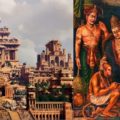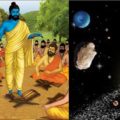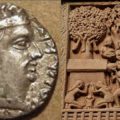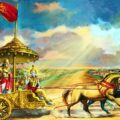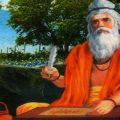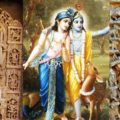Outline of Indian Chronology: Manu (14500 BCE) to Vikramaditya (1 BCE)
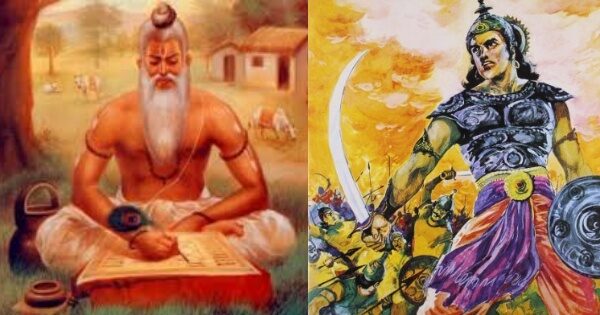
The antiquity and the chronology of ancient Indian civilization can be presented in seven distinct stages as follows:
1. Early Vedic Period (14500-13000 BCE)
2. Vedic Period (13000-10500 BCE)
3. Post Vedic Period (10500-6777 BCE)
4. The 28th Treta Yuga Period (6777-5577 BCE)
5. The 28th Dvapara Yuga Period (5577-3176 BCE)
6. The Epoch of Mahabharata War (3162 BCE)
7. The 28th Kaliyuga Period: From Mahabharata War to King Vikramaditya (From 3162 BCE to 1 BCE).
|
Indian Chronology: Early Vedic Period (14500-13000 BCE)
|
||
|
15962 BCE |
The Epoch of Adiyuga |
9185 years (1837 nos of 5-year Yugas) before 6777 BCE (beginning of 28th Treta Yuga of 7th Manvantara) |
|
14500 BCE |
Brahma I |
Summer Solstice at Dhanishtha Nakshatra |
|
14480 BCE |
Svayambhuva Manu (Founder of Manu/Ikshvaku/Surya Vamsh) |
|
|
14480 BCE |
Saptarshis (Atri, Marichi, Vasishtha, Angiras, Pulaha, Pulastya and Kratu) |
|
|
14450 BCE |
Uttanapada |
|
|
14400 BCE |
Dhruva |
|
|
14310 BCE |
Rishabhadev |
|
|
14030 BCE |
King Prithu |
|
|
14030 BCE |
Kashyapa I, Aditi, Diti |
|
|
14011 BCE |
Birth of Brihaspati I |
Conjunction of Sun, Moon, Jupiter and Winter solstice at Tishya Nakshatra |
|
14000 BCE |
Adityas (Indra I, Vishnu I etc.) and Daityas |
|
|
14000 BCE |
Devas (Adityas) and Asuras (Daityas) |
|
|
14000 BCE |
Rudra I, Eight Vasus, Manu & Ida |
|
|
14000 BCE |
Soma (Founder of Chandra Vamsh) |
|
|
13950 BCE |
King Puru I |
|
|
13800 BCE |
City of Ayodhya was founded by Manu |
|
|
13650 BCE |
Indra II & Vritasura (Beginning of Political power struggle between Devas and Asuras) |
|
|
13650 BCE |
Rishi Dadhichi |
|
|
13630 BCE |
Ashvini Kumaras, Rishi Chyavana |
|
|
13550 BCE |
Marutta Avikshita and Vishve Devaah |
|
|
13500 BCE |
King Trishanku |
|
|
13500 BCE |
Vasishtha II & Jamadagni I |
Autumnal Equinox at Ashvini Nakshatra |
|
13500 BCE |
Vishvamitra I & Menaka |
Summer Solstice at Sravana Nakshatra |
|
13480 BCE |
Dushyanta & Shakuntala, Rishi Kanva |
|
|
13450 BCE |
King Bharata & Rishi Dirghatamas I |
|
|
13450 BCE |
Sauvira, Madra, Kekaya, Anga, Vanga, Kalinga, Pundra, Suhma, Kanyakubja, Kampilya, Kaushambi, Girivraja, Matsya, Saurashtra came into existence. |
|
|
|
|
|
|
|
|
|
|
Indian Chronology: Vedic Period (13000-10500 BCE)
|
||
|
13400 BCE |
Swarochisha Manu (Manu II) |
|
|
13200 BCE |
Uttama Manu (Manu III) |
|
|
13000 BCE |
Tapasa Manu (Manu IV) |
|
|
12600 BCE |
Raivata Manu (Manu V) [Founder of Kushasthali city in Saurashtra near Girnar hills which came to be known as Raivatak Parvat] |
Autumnal Equinox at Revati Nakshatra |
|
12300 BCE |
King Vidarbha [Vidarbha kingdom] |
|
|
12000 BCE |
Kushasthali city was sunk in the sea but the island resurfaced later. |
During Meltwater Pulse 1A |
|
11800 BCE |
Chakshusha Manu (Manu VI) |
|
|
11500 BCE |
Ajamidha II, Bahyashva [Founder of Panchalas] |
|
|
11500 BCE |
Vrishni of Yadu dynasty |
|
|
11500 BCE |
Founder of Kuru dynasty |
|
|
11300 BCE |
Indra III & Shambara |
|
|
11270 BCE |
Datta Atreya |
|
|
11270 BCE |
Vaivasvata Manu |
|
|
11250 BCE |
King Ikshvaku |
|
|
11250 BCE |
Dasharajna War |
|
|
11240 BCE |
Aila Pururava & Urvashi |
|
|
11218 BCE |
Daksha Yajna (Shiva & Sati) Vriddhagarga: Kaliketu rises from the east stationed in the region of Jyeshtha, Mula and Anuradha nakshatras. This observation of Kaliketu corresponds to Hailey’s Comet in Aug-Sep 11218 BCE. |
|
|
11226 BCE |
Agastya and First Tamil Sangam |
|
|
11220 BCE |
Shukracharya |
|
|
11220 BCE |
Hiranyakashyap, Prahlad |
|
|
11200 BCE |
Great Flood in Manu’s Kingdom [in Saurashtra] |
|
|
11200 BCE |
Vishvamitra III |
|
|
11200 BCE |
Arjuna Kartavirya |
|
|
11200 BCE |
List of Nakshatras starting from Mrigashira |
Winter Solstice shifted to Mrigashira |
|
11175 BCE |
Madhuchchandas, son of Vishvamitra [Author of first sukta of Rigveda] |
|
|
11177 BCE |
Parashurama I |
|
|
11170 BCE |
Veda Vyasa I [Compiled four Vedas] & Ganesha |
|
|
11160 BCE |
Vamana and King Bali |
|
|
11153 BCE |
Birth of Devakiputra Krishna |
25th May 11153 BCE |
|
11142 BCE |
Kansa was killed by Krishna Andhaka tells Kamsa a comet crossed 13 nakshatras starting from Bharani. केतुना धूमकेतोस्तु नक्षत्राणि त्रयोदश I भरण्यादीनि विद्धानि नानुयान्ति निशाकरम् II हरिवंश, Vishnu Parva. 23.27. Hailey’s Comet was in Bharani on 10 Sep 11143 BCE (Apparent Magnitude 8.5). It moved to Purva Bhadrapada in Jan 11142 BCE. During the period from 21 Jan 11142 BCE to 21 Feb 11142 BCE, Hailey’s Comet crossed 180 degrees from Purva Bhadrapada nakshatra to Purva Phalguni, exactly 13 nakshatras. Sri Krishna killed Kamsa on Magha Amavasya (24 Nov 11142 BCE) when he was 11 y 6 m old. |
|
|
11150 BCE |
King Mandhata |
|
|
11130 BCE |
Paila, Vaishampayana, Jaimini, Sumantu and Romaharshana Suta |
|
|
11100 BCE |
Jaiminiya Ashvamedha [History of Vedic Kuru Kings] |
|
|
11000 BCE |
Taittiriya Samhita, Vajasaneya Samhita |
|
|
10950 BCE |
Videha Madhava and Gautama Rahugana |
|
|
10950 BCE |
Sarasvati River lost in sands at Vinashana and started flowing westwards. |
|
|
10880 BCE |
Videha King Janak,Yajnavalkya, Gargi |
|
|
10880 BCE |
Uddalaka Aruni, Shetaketu, Kaushitaki |
|
|
10850 BCE |
Rishi Pippalada, Paippalada Samhita |
|
|
10800 BCE |
Rishi Maitrayana, Maitrayani Samhita |
|
|
10800 BCE |
Shakala and Bashkala Branches of Rigveda |
|
|
10700 BCE |
Videha King Nimi performed Sarasvati Satra |
|
|
10500 BCE |
Compilation of Shakala Samhita of Rigveda
|
|
|
Indian Chronology: Post Vedic Period (10500-6777 BCE)
|
||
|
10500 BCE |
Vedic period ends with large scale migrations eastwards and southwards from the banks of Sarasvati River and Sapta Sindhu region due to arid climate. Vedic Sarasvati river (Kurukshetra to Prabhas Patan) disappeared at Vinashana and started flowing westwards from Kurukshetra to Sindh to Gujarat. Ikshvaku kings moved to Ayodhya and Videha kings shifted to Mithila. |
|
|
11050-10050 BCE |
1000-year Satra was performed in Naimisharanya. Ugrashravas Suta, son of Romaharshana Suta (disciple of Veda Vyasa I) and Rishi Shaunaka started this Satra. |
|
|
10200 BCE |
Resetting of List of Nakshatras starting from Rohini and Magha Shukla Pratipada in Dhanishtha Nakshatra (at Autumnal equinox). |
Winter Solstice shifted to Rohini |
|
10500-9500 BCE |
Seemingly, Sapta Sindhu region was under Arid climate. |
|
|
9300 BCE |
Dvaravati city was submerged by sea |
During Meltwater Pulse 1B |
|
9300 BCE |
Compilation of Panchavimsha Brahmana and Prashnopanishad. |
|
|
9200 BCE |
Rishi Mahidasa Aitareya wrote Aitareya Brahmana. |
|
|
9200 BCE |
List of Nakshatras starting from Krittika |
Winter Solstice shifted to Krittika |
|
9200 BCE |
Compilation of Nakshatra Sukta of Atharvaveda |
|
|
9000 BCE |
Compilation of Jaiminiya Brahmana, Tavalkara Upanishad Brahmana, Kenopanishad. |
|
|
8800 BCE |
Compilation of Shatapatha Brahmana and Brihadaranyakopanishad, Taittiriya Brahmana, Aranyaka, Upanishad, Kathaka & Kapishthala Samhitas, Maitrayani Samhita, Brahmana, Aranyaka, Upanishad, Chandogyopanishad |
|
|
8500 BCE |
Exclusion of Abhijit Nakshatra (27 Nakshatras) |
|
|
8000 BCE |
Compilation of Gopatha Brahmana |
|
|
7500 BCE |
Compilation of Samavidhana Brahmana |
|
|
7500-6500 BCE |
Shrautasutras, Grihyasutras, Shulbasutras and Dharmasutras, Sankhya and Mimansa Darshana Sutras, Sushruta Samhita and Charaka Samhita, Pingala’s Chanda Shastra, Patanjali’s Yoga Darshana |
|
|
7322 BCE |
List of Nakshatras starting from Ashvini |
Winter Solstice shifted to Ashvini |
|
6778 BCE |
Mayasura wrote Surya Siddhanta |
|
|
10500-7322 BCE |
Ikshvakus and Videha Kings were ruling over Ayodhya and Mithila respectively. Kurus and Panchalas were ruling over some areas of Sapta Sindhu region. Pandyas were ruling over Tamilnadu and Kerala. Ashmaka and Kuntala Kings were ruling over Andhra, Karnataka and Maharashtra regions. Unfortunately, we have irretrievably lost the genealogical data of the Ikshvaku kings because later Puranic updaters mistakenly assumed 7322 BCE as the beginning of Vaivasvata Manvantara instead of 11200 BCE. |
|
Indian Chronology: 28th Treta Yuga Period (6777-5577 BCE)
|
7322 BCE |
List of Nakshatras starting from Ashvini |
Winter Solstice shifted to Ashvini |
|
7322 BCE |
Counting of Chaturyugas of 20 years in a new series. |
Sun, Moon and Brihaspati were in conjunction at Tishya = Pushya nakshatra at vernal equinox (on 24 May 7321 BCE) |
|
6782 BCE |
27 Chaturyugas of 20 years elapsed and the 28th Kritayuga commenced in 6782 BCE. |
|
|
6778 BCE |
Mayasura wrote Surya Siddhanta |
All planets, Sun and Moon were in a great conjunction in Aries on 22 Feb 6778 BCE. |
|
6777 BCE |
28th Treta Yuga of 1200 years commenced. |
12-year cycle and 60-year cycle were introduced. |
|
6777 BCE |
First Saptarshi Cycle of 2700 years commenced |
|
|
6773 BCE |
Introduction of Brahma Siddhanta Calendar and 6773 BCE was Prabhava Samvatsara |
|
|
6500 BCE |
Upavedas were compiled. Yaska wrote Nirukta. |
|
|
6000 BCE |
Compilation of Bharat Natya Shastra |
|
|
5977 BCE |
Introduction of Vasishtha Siddhanta |
|
|
5650 BCE |
Matanga Muni wrote Brihaddeshi |
|
Ikshvaku Kings of Ayodhya
|
1. |
Śaśāda |
7450-7400 BCE |
|
2. |
Kakustha I |
7400-7380 BCE |
|
3. |
Anenāḥ or Suyodhana |
7380-7350 BCE |
|
4. |
Prithu |
7350-7330 BCE |
|
5. |
Viśvagaśva |
7330-7300 BCE |
|
6. |
Ardra or Damaka or Indu |
7300-7280 BCE |
|
7. |
Yuvanāśva II |
7280-7250 BCE |
|
8. |
Śrāvasta (the founder of the city of Śrāvastī) |
7250-7230 BCE |
|
9. |
Brihadaśva |
7230-7200 BCE |
|
10. |
Kuvalāśva II |
7200-7180 BCE |
|
11. |
Driḍhāśva |
7150-7130 BCE |
|
12. |
Pramoda |
7130-7100 BCE |
|
13. |
Haryāśva I |
7100-7080 BCE |
|
14. |
Nikumbha |
7080-7060 BCE |
|
15. |
Saṁhatāśva |
7060-7040 BCE |
|
16. |
Kriṣāśva and Akritāśva |
7040-7020 BCE |
|
17. |
Prasenajit (Son of Kriṣāśva) |
7020-7000 BCE |
|
18. |
Yuvanāśva III and Māndhātā II (Sons of Prasenajit) |
7000-6980 BCE |
|
19. |
Māndhātā II |
6980-6950 BCE |
|
20. |
Purukutsa (Son of Māndhātā II) |
6950-6930 BCE |
|
21. |
Vasuda (Son of Purukutsa) |
6930-6900 BCE |
|
22. |
Saṁbhūta |
6900-6880 BCE |
|
23. |
Anaraṇya I |
6880-6860 BCE |
|
24. |
Trisadaśva |
6860-6840 BCE |
|
25. |
Haryāśva II |
6840-6820 BCE |
|
26. |
Vasumata |
6820-6800 BCE |
|
27. |
Tridhanvā |
6800-6780 BCE |
|
28. |
Tryāruṇa |
6780-6760 BCE |
|
29. |
Satyavrata |
6760-6730 BCE |
|
30. |
Satyaratha |
6730-6700 BCE |
|
31. |
Hariśchandra |
6700-6670 BCE |
|
32. |
Rohitāśva |
6670-6630 BCE |
|
33. |
Hārīta, Chanchu |
6630-6600 BCE |
|
34. |
Vijaya |
6600-6560 BCE |
|
35. |
Ruruka |
6560-6530 BCE |
|
36. |
Vrika |
6530-6500 BCE |
|
37. |
Bāhu |
6500-6460 BCE |
|
38. |
Sagara II |
6460-6430 BCE |
|
39. |
Asamañjasa |
6430-6400 BCE |
|
40. |
Aṅśumān |
6400-6360 BCE |
|
41. |
Dilīpa I Khaṭvāṅga |
6360-6330 BCE |
|
42. |
Bhāgīratha II |
6330-6300 BCE |
|
43. |
Śruta or Śrutasena |
6300-6270 BCE |
|
44. |
Nābhāga |
6270-6230 BCE |
|
45. |
Ambarīṣa |
6230-6200 BCE |
|
46. |
Sindhudvīpa |
6200-6160 BCE |
|
47. |
Ayutāyu or Ayutajit |
6160-6120 BCE |
|
49. |
Rituparṇa |
6120-6080 BCE |
|
50. |
Ārtaparṇi or Kalmāṣapāda II or Mitrasaha |
6080-6040 BCE |
|
51. |
Sarvakarma |
6040-6000 BCE |
|
52. |
Anaraṇya II |
6000-5960 BCE |
|
53. |
Mūlaka |
5960-5920 BCE |
|
54. |
Śataratha |
5920-5880 BCE |
|
55. |
Ilavilā or Ailavila |
5880-5840 BCE |
|
56. |
Viśvasaha |
5840-5800 BCE |
|
|
The genealogy (Kālidāsa’s Raghu Vaṁśa) |
|
|
57. |
Dilīpa II Ailavila (Son of Ilavila) |
5800-5770 BCE |
|
58. |
Raghu II or Dīrghabāhu |
5770-5740 BCE |
|
59. |
Aja |
5740-5700 BCE |
|
60. |
Daśaratha |
5700-5649 BCE |
61. Sri Rāma (5635-5603 BCE).
|
Indian Chronology: 28th Dvapara Yuga Period (5577-3177 BCE)
|
||
|
5577 BCE |
Beginning of Dvapara Yuga of 2400 years. The time span of Chaturyuga has been increased to 12000 years with differential duration of Yugas (1:2:3:4). Thus, the 28th Dvapara Yuga lasted for 2400 years. |
|
|
5000 BCE |
Compilation of Manusmriti |
|
|
5000 BCE |
Akshapada Gautama and Kanada (Compilation of Nyaya and Vaisheshika sutras) |
|
|
5000-4300 BCE |
Introduction of Yavana, Romaka and Paulisha Siddhantas based on Surya Siddhanta. |
|
|
4326 BCE |
A Vaishnava tradition of 60-year cycle. 4326 BCE was the Prabhava Samvatsara. |
|
|
3176 BCE |
Saptarshi Cycle entered in Magha Nakshatra (3176-3076 BCE) |
|
|
3162 BCE |
Mahabharata War and the epoch of Yudhishthira Samvat |
|
Ikshvaku Kings of Ayodhya
|
61. |
Rāma |
5635-5603 BCE |
|
62. |
Kuśa |
5602-5550 BCE |
|
63. |
Atithi (killed in a war with Asura Durjaya.) |
5550-5520 BCE |
|
64. |
Niṣāda |
5520-5480 BCE |
|
65. |
Nala |
5480-5440 BCE |
|
66. |
Nabhas |
5440-5400 BCE |
|
67. |
Punḍarīka |
5400-5370 BCE |
|
68. |
Kśemadhanvā |
5370-5330 BCE |
|
69. |
Devānīka |
5330-5300 BCE |
|
70. |
Ahināgu |
5300-5260 BCE |
|
71. |
Paripātra |
5260-5230 BCE |
|
72. |
Śīla |
5230-5200 BCE |
|
73. |
Unnābha |
5200-5170 BCE |
|
74. |
Vajranābha |
5170-5140 BCE |
|
75. |
Śaṅkhana |
5140-5100 BCE |
|
76. |
Vyuṣitāśva |
5100-5070 BCE |
|
77. |
Viśvasaha |
5070-5040 BCE |
|
78. |
Hiraṇyanābha |
5040-5000 BCE |
|
79. |
Kauśalya |
5000-4970 BCE |
|
80. |
Brahmiṣṭha |
4970-4930 BCE |
|
81. |
Putra |
4930-4900 BCE |
|
82. |
Puṣya |
4900-4870 BCE |
|
83. |
Dhruvasandhi (killed by a lion when his son Sudarśana was six years old) |
4870-4850 BCE |
|
84. |
Sudarśana |
4850-4800 BCE |
|
85. |
Agnivarṇa |
4800-4780 BCE |
|
86. |
Wife of Agnivarṇa |
4780-4750 BCE |
Ikshvaku Kingdom declined after 4750 BCE
Kuru Kings of Dvapara Yuga
|
1. |
Puru |
4350-4300 BCE |
|
2. |
Janamejaya |
4300-4270 BCE |
|
3. |
Prachīnvān |
4270-4230 BCE |
|
4. |
Saṁyāti |
4230-4200 BCE |
|
5. |
Ahamyāti |
4200-4170 BCE |
|
6. |
Sārvabhauma |
4170-4130 BCE |
|
7. |
Jayatsena |
4130-4100 BCE |
|
8. |
Arāchina |
4100-4070 BCE |
|
9. |
Mahābhauma |
4070-4030 BCE |
|
10. |
Ayutanāyi |
4030-4000 BCE |
|
11. |
Akrodhana |
4000-3970 BCE |
|
12. |
Devātithi |
3970-3930 BCE |
|
13. |
Richah |
3930-3900 BCE |
|
14. |
Rikśa |
3900-3870 BCE |
|
15. |
Matināra |
3870-3830 BCE |
|
16. |
Tansu |
3830-3800 BCE |
|
17. |
Ilina |
3800-3770 BCE |
|
18. |
Duḥṣanta |
3770-3730 BCE |
|
19. |
Bharata |
3730-3700 BCE |
|
20. |
Bhumanyu |
3700-3670 BCE |
|
21. |
Suhotra |
3670-3630 BCE |
|
22. |
Hasti II |
3630-3600 BCE |
|
23. |
Vikunthina |
3600-3570 BCE |
|
24. |
Ajamīḍha II |
3570-3530 BCE |
|
25. |
Saṁvaraṇa IV |
3530-3500 BCE |
|
26. |
Kuru III |
3500-3470 BCE |
|
27. |
Vidūratha |
3470-3430 BCE |
|
28. |
Arugvan |
3430-3400 BCE |
|
29. |
Parīkśit |
3400-3370 BCE |
|
30. |
Bhimasena |
3370-3330 BCE |
|
31. |
Paryaśravas |
3330-3290 BCE |
|
32. |
Śāntanu |
3290-3240 BCE |
|
33. |
Vichitravīrya |
3240-3210 BCE |
|
34. |
Dhritarāṣṭra |
3210-3162 BCE |
|
35. |
Yudhiṣṭhira |
3162-3126 BCE |
|
36. |
Parikshit |
3126-3100 BCE |
Indian Chronology: From Mahabharata War to King Vikramaditya (3162 BCE to 1 BCE)
|
|
Dynasty |
Duration |
In CE |
|||||||||||||||||||||||||||||||||||||||
|
1. |
Bṛhadratha Dynasty |
1000 y |
3162-2162 BCE |
|||||||||||||||||||||||||||||||||||||||
|
2. |
Pradyota Dynasty |
138 y |
2162-2024 BCE |
|||||||||||||||||||||||||||||||||||||||
|
3. |
Śiśunāga Dynasty |
360 y |
2024-1664 BCE |
|||||||||||||||||||||||||||||||||||||||
|
||||||||||||||||||||||||||||||||||||||||||
|
4. |
Nanda Dynasty |
(100 y?) |
1664-1596 BCE |
|||||||||||||||||||||||||||||||||||||||
|
Mahāpadma Nanda ascended the throne 1500 years after Mahābhārata war (3162 BCE). The Saptarṣis were in Pūrvabhadrā Nakśatra around 1677-1577 BCE. |
||||||||||||||||||||||||||||||||||||||||||
|
5. |
Maurya Dynasty |
137 y |
1596-1459 BCE |
|||||||||||||||||||||||||||||||||||||||
|
||||||||||||||||||||||||||||||||||||||||||
|
6. |
Śuṅga Dynasty |
112 y |
1459-1346 BCE |
|||||||||||||||||||||||||||||||||||||||
|
7. |
Kaṇva Dynasty |
45 y |
1346-1301 BCE |
|||||||||||||||||||||||||||||||||||||||
|
8. |
Decline of Magadha Empire |
— |
1301-826 BCE |
|||||||||||||||||||||||||||||||||||||||
|
|
|
|||||||||||||||||||||||||||||||||||||||||
|
9. |
Śātavāhana Dynasty |
492 y |
826-334 BCE |
|||||||||||||||||||||||||||||||||||||||
|
10. |
Gupta Dynasty |
245 y |
334-89 BCE |
|||||||||||||||||||||||||||||||||||||||
|
11. |
King Vikramaditya of Ujjain |
|
82-1 BCE |
|||||||||||||||||||||||||||||||||||||||
Featured image courtesy on Indian chronology (representation purpose only): Google, Amar Chitra Katha.
Vedveer Arya
Latest posts by Vedveer Arya (see all)
- How Salaries Were Paid to Temple Staff in Early Medieval Bharat - July 27, 2024
- A Genealogical Account of Bhrigu Gotra from Saptarshis - July 27, 2024
- Saptarshis: Lineages of Angirasa gotra from 14050 BCE - July 27, 2024

